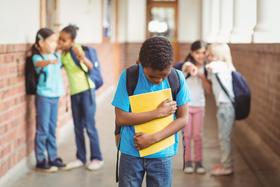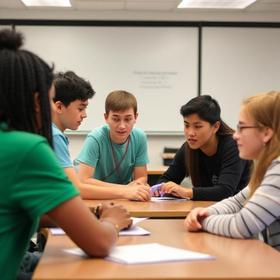Serving 386 students in grades Prekindergarten-5, Orems Elementary School ranks in the bottom 50% of all schools in Maryland for overall test scores (math proficiency is bottom 50%, and reading proficiency is bottom 50%).
The percentage of students achieving proficiency in math is 20-24% (which is lower than the Maryland state average of 27%). The percentage of students achieving proficiency in reading/language arts is 35-39% (which is lower than the Maryland state average of 45%).
The student-teacher ratio of 16:1 is higher than the Maryland state level of 14:1.
Minority enrollment is 63% of the student body (majority Black and Hispanic), which is lower than the Maryland state average of 68% (majority Black).
Quick Facts (2025-26)
- Grades: Prekindergarten-5
- Enrollment: 386 students
- Student-Teacher Ratio: 16:1
- Minority Enrollment: 63%
- Overall Testing Rank: Bottom 50% in MD
- Math Proficiency: 20-24% (Btm 50%)
- Reading Proficiency: 35-39% (Btm 50%)
- Science Proficiency: 20-24% (Btm 50%)
- Source: National Center for Education Statistics (NCES), MD Dept. of Education
Top Rankings
Orems Elementary School ranks among the top 20% of public schools in Maryland for:
Category
Attribute
Diversity
School Overview
Orems Elementary School's student population of 386 students has stayed relatively flat over five school years.
The teacher population of 24 teachers has declined by 7% over five school years.
Grades Offered
Grades Prekindergarten-5
(Supplemental Virtual)
(Supplemental Virtual)
Total Students
386 students
Gender %
Total Classroom Teachers
24 teachers
School Calendar
School Rankings
Orems Elementary School ranks within the bottom 50% of all 1,338 schools in Maryland (based off of combined math and reading proficiency testing data).
The diversity score of Orems Elementary School is 0.75, which is more than the diversity score at state average of 0.74. The school's diversity has stayed relatively flat over five school years.
Overall Testing Rank
#756 out of 1338 schools
(Bottom 50%)
(Bottom 50%)
Math Test Scores (% Proficient)
20-24%
27%
Reading/Language Arts Test Scores (% Proficient)
35-39%
45%
Science Test Scores (% Proficient)
20-24%
36%
Student-Teacher Ratio
16:1
14:1
American Indian
1%
n/a
Asian
6%
7%
Hispanic
24%
23%
Black
24%
33%
White
37%
32%
Hawaiian
n/a
n/a
Two or more races
8%
5%
All Ethnic Groups
Participates in the National School Lunch Program (NSLP)
Yes
Eligible for Free Lunch
58%
44%
Eligible for Reduced Lunch
6%
5%
School Statewide Testing
School District Name
Source: National Center for Education Statistics (NCES), MD Dept. of Education
Profile last updated: 02/09/2025
Frequently Asked Questions
What is Orems Elementary School's ranking?
Orems Elementary School is ranked #756 out of 1,338 schools, which ranks it among the bottom 50% of public schools in Maryland.
What schools are Orems Elementary School often compared to?
Orems Elementary Schoolis often viewed alongside schools like Owings Mills Elementary School, Oliver Beach Elementary School by visitors of our site.
What percent of students have achieved state testing proficiency in math and reading?
20-24% of students have achieved math proficiency (compared to the 27% MD state average), while 35-39% of students have achieved reading proficiency (compared to the 45% MD state average).
How many students attend Orems Elementary School?
386 students attend Orems Elementary School.
What is the racial composition of the student body?
37% of Orems Elementary School students are White, 24% of students are Hispanic, 24% of students are Black, 8% of students are Two or more races, 6% of students are Asian, and 1% of students are American Indian.
What is the student-teacher ratio of Orems Elementary School?
Orems Elementary School has a student ration of 16:1, which is higher than the Maryland state average of 14:1.
What grades does Orems Elementary School offer ?
Orems Elementary School offers enrollment in grades Prekindergarten-5 (Supplemental Virtual).
What school district is Orems Elementary School part of?
Orems Elementary School is part of Baltimore County Public Schools.
School Reviews
2 10/10/2025
This school is seriously in need of major changes. They need new technology and a change for the better. Overall the teacher's are great, and really care for for our children. But they need to reconsider some of the work they expect the younger children be able to do. Also the communication between the parents and the school isn't very good. Communication should be the key for the children to succeed, which isn't happening here. Their response is that they have too many children to deal with. Even when the child has special needs they don't communicate well, and has to go though the school principal or asst principal for approval. The parking at the school is terrible. You gotta provide proof for everything even down to have a child with medical needs to prove they have to have limits or what ever. Gotta fight for everything....and pretty much you face a lot of negatively the way they talk to you as a parent. Orem's is in need of major changes...
Review Orems Elementary School. Reviews should be a few sentences in length. Please include any comments on:
- Quality of academic programs, teachers, and facilities
- Availability of music, art, sports and other extracurricular activities
Recent Articles

Bullying, Name-Calling & Put-Downs: Parent Guide 2025
Practical tips for parents to address bullying, name-calling, and put-downs鈥攚ith 2025 data, policies, and expert strategies.

What Is a Magnet School? (2025 Guide)
Explore what a magnet school is, how it works, and its benefits in 2025. Clear explanation for parents, students, and educators.

Cooperative Learning in 2025: Evidence, Best Practices & Challenges
Explore cooperative learning in 2025鈥攏ew data, updated practices, expert insights for educators and families.





